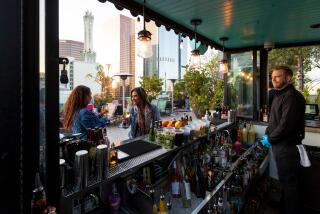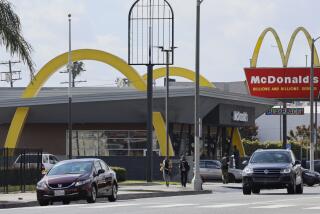L.A.-area restaurants adding healthcare surcharge to cover workers

Some L.A.-area restaurants are charging customers a 3% healthcare fee to provide workers with insurance.
Diners are discovering an unfamiliar new item when the bill comes for the truffled lobster Bolognese at Melisse and for the crunchy Spanish fried chicken and waffles at AOC — a 3% surcharge for employees’ medical insurance.
The charge first appeared at one Los Angeles-area restaurant late last year; by early September, more than a dozen mainly high-end eateries followed suit. The added cost has given some diners heartburn and thrust the restaurants’ owners unwillingly into the debate over the Affordable Care Act.
The healthcare surcharge, the restaurant owners insist, isn’t a political statement, but a way to offer valuable benefits to employees while maintaining their profits, which are slim even at the most successful establishments.
“We want our staff to have healthcare,” said Josh Loeb, the co-owner of popular dining spots including Milo & Olive and Rustic Canyon. “It’s not because we support Obama or don’t support Obama, or are Democrats or are not Democrats.”
The Los Angeles-area restaurants aren’t the first to charge customers to cover healthcare.
After San Francisco implemented a healthcare mandate in 2008, many restaurants there adopted a surcharge to cover the cost of health insurance for employees.
Last December, Los Angeles restaurateur Bill Chait made a splash by introducing a 3% “Healthy LA” charge at his French restaurant Republique on South La Brea Avenue.
Loeb said he was inspired by the Northern California pioneers and emailed a group of “like-minded” restaurant owners earlier this year to see whether they could plan a course of action together. The owners he reached out to, Loeb said, all run high-quality spots with many of the same clientele.
Among those on the list: Caroline Styne and Suzanne Goin of Lucques, Tavern and AOC; Jon Shook and Vinny Dotolo of Son of a Gun and Animal; and David Lentz of the Hungry Cat restaurants.
Many of the restaurant owners said they had been mulling over providing health insurance for years. They took the plunge after watching the Affordable Care Act pass and seeing other businesses find ways to offer healthcare for their employees.
“We decided it would be a good thing to do it as a group,” said Josiah Citrin, the chef-owner of Melisse in Santa Monica. “Usually when lots of people do things it’s easier to make change.”
Citrin joined in even though Melisse doesn’t have enough workers to fall under the employer mandate that starts in 2016. That provision of the act requires businesses with more than 50 full-time workers to provide health insurance. The coverage will be a particular boon to longtime employees who are getting older, he said.
Younger restaurant workers such as Sarah Huxhold are also cheering the surcharge.
Huxhold, a 31-year-old server at Milo & Olive in Santa Monica, said she lost her insurance through work last year after quitting to pursue a career in music. While out of work, her mom helped her buy coverage for about $500 a month, but Huxhold decided it was too expensive and dropped the plan in December.
Since then, the Baldwin Hills resident said she has tried unsuccessfully to get insurance through Medi-Cal. She’s been forced to scour Groupon for a deal on eye exams and pinned her glasses together to avoid getting a new pair.
Now that she will have insurance, she plans to get an annual physical and visit the dentist and optometrist.
“I’m really excited about having insurance again,” Huxhold said. “There is no way I can pay for those things out of pocket.”
But restaurants face an uphill battle to explain the surcharge to confused customers such as Bruce Morman.
The Hancock Park architect, a fan of fine dining, said he doesn’t mind paying a few extra dollars to provide healthcare to restaurant workers. But he doesn’t want to see an extra line on his bill or have a conversation with his waiter about health insurance. The 53-year-old said he’d prefer to have that cost built into menu prices.
“It should be seamless,” Morman said. “I don’t want to think about it.”
Online reviewers have been more blunt. On Yelp, some diners have called the fee crazy, cheap and tacky. “It’s basically management saying ‘Obamacare made me do it,’ ” one reviewer wrote. “If you want to offset costs try turning up the thermostat. There’s your 3%! Now please pay your workers’ health insurance, and hush.”
The restaurants say increasing menu prices is not as effective as a surcharge.
Costs such as rent and liability insurance often are calculated as a percentage of revenue, so prices would have to be bumped up higher than 3% to raise the same amount as a surcharge, they said.
Restaurants on average make only 5 cents profit for every dollar of revenue, because they are labor-intensive businesses with high costs, said Styne of AOC, Lucques and Tavern.
“There is a misconception out there that the restaurants are reaping such high profits that we should just take less profit,” she said. “Many months, no matter how busy the restaurants may be, they can actually be running at a loss.”
Chait, managing partner of Republique, Petty Cash, Bestia and other L.A. hot spots, said a big motivator for providing healthcare was smoothing out pay inequality between employees who serve customers and the cooks, Chait said.
California’s long-standing gratuity law bars cooks and back-of-the-house staff from sharing in tips. With tips, some of his servers can make as much as $80,000 a year, vastly outstripping the
amounts earned by those who toil in the kitchen.
Son of a Gun and Animal have debated rolling out an all-inclusive service fee — which would replace the tip and cover healthcare costs — after signing up workers for insurance this fall, said Helen Johannesen, director of operations. Chait said the restaurant he is working on opening next year at the Broad contemporary art museum will nix tipping as well.
Jot Condie, chief executive of the California Restaurant Assn., said he doubted that a healthcare surcharge would be widely adopted but added that more restaurants might go for an all-inclusive service fee.
“Once it starts you are going to see other segments in the industry, whether coffee shops or ice cream shops, dip their toe in,” Condie said. “If they see it’s manageable and customers do not revolt.”
So far, the restaurant owners say the reception from customers has been mostly positive — although a few have grumbled.
Loeb said just a handful of people have asked for the new fee to be taken off their bill.
One diner, according to Loeb, said: “We’re from the South, and we don’t believe in universal healthcare.”
Twitter: @ByShanLi







